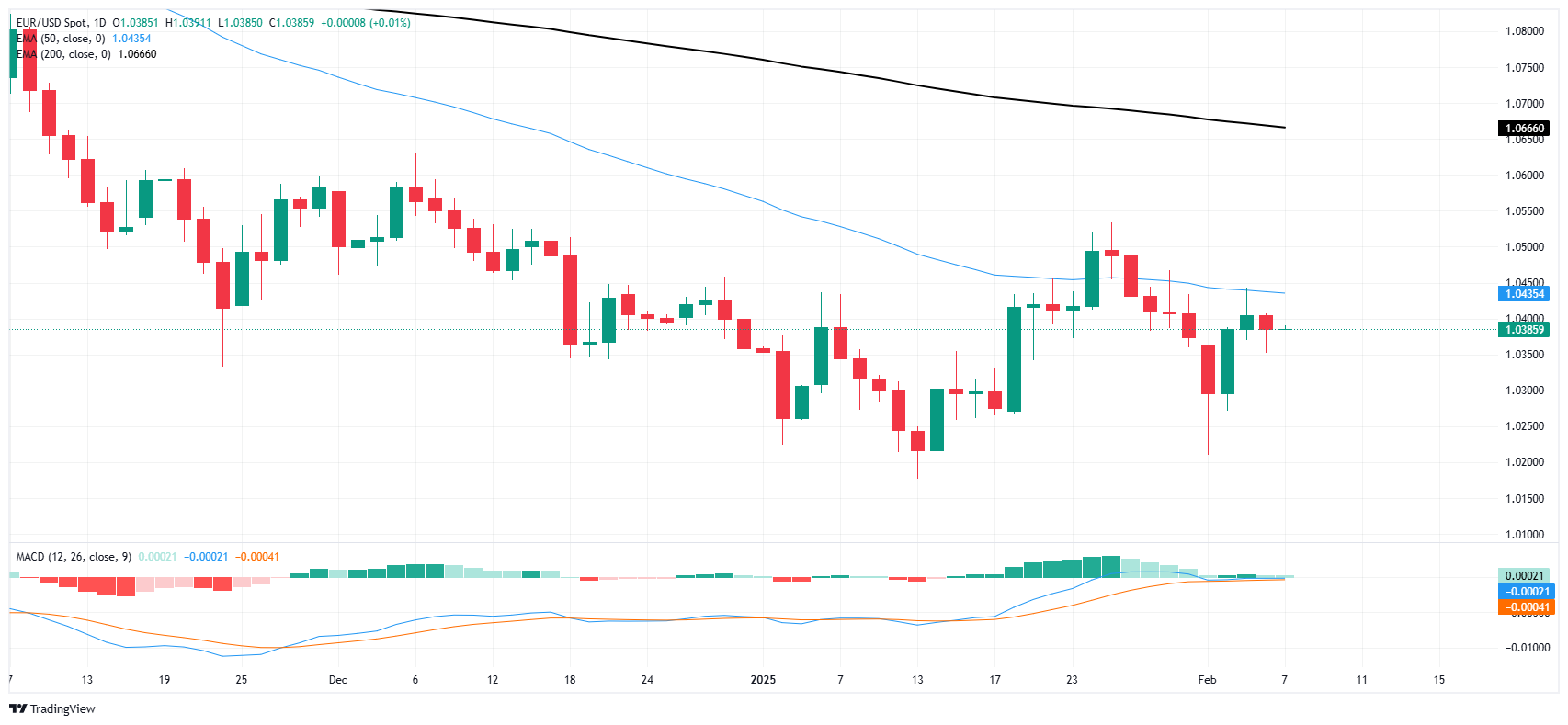EUR/USD hobbles into another NFP Friday
- EUR/USD remains stuck near the 1.0400 handle heading into Friday.
- European Retail Sales failed to kickstart Fiber trading.
- US NFP jobs data remains the key focus for the trading week.
EUR/USD churned some chart paper on Thursday, testing to the low side but wrapped up the day remaining stubbornly stuck near the 1.0400 handle. Euro bidders were entirely uninspired by Pan-EU Retail Sales figures that came in exactly as expected. Greenback traders treaded water ahead of Friday’s fresh print of US Nonfarm Payrolls (NFP) figures.
European Retail Sales growth came in at 1.9% YoY in December, matching median market forecasts and gaining slight ground over the revised previous figure of 1.6%. Despite the upswing in annualized figures, MoM Retail Sales actually contracted, printing at -0.2% compared to the previous month’s flat print of 0.0%, which was also revised slightly lower.
Economic data from the US was primarily mid-tier on Thursday, with weekly Initial Jobless Claims rising to 219K for the week ending January 31. Analysts had anticipated a figure of 213K, while the prior week’s number was slightly adjusted to 208K.
A new release of Nonfarm Payrolls (NFP) is set for Friday, with net job additions projected to decrease to 170K for January, compared to December’s figure of 256K. This week will see close scrutiny of revisions to older data. Historically, post-release revisions have tended to show stronger results in 2024, frustrating market participants who hoped to see weaknesses in the US job market that might encourage the Federal Reserve (Fed) to enact further rate cuts.
EUR/USD price forecast
EUR/USD saw some volatility on Thursday during the early hours, but ended the day down a scant 0.2% as price action remains stuck to the 1.0400 handle. Bids remain capped by the 50-day Exponential Moving Average (EMA) near 1.0440. Fiber managed to eke out a bullish recovery after the early week’s plunge toward the 1.0200 handle, but topside momentum remains limited.
EUR/USD daily chart
Euro FAQs
The Euro is the currency for the 19 European Union countries that belong to the Eurozone. It is the second most heavily traded currency in the world behind the US Dollar. In 2022, it accounted for 31% of all foreign exchange transactions, with an average daily turnover of over $2.2 trillion a day. EUR/USD is the most heavily traded currency pair in the world, accounting for an estimated 30% off all transactions, followed by EUR/JPY (4%), EUR/GBP (3%) and EUR/AUD (2%).
The European Central Bank (ECB) in Frankfurt, Germany, is the reserve bank for the Eurozone. The ECB sets interest rates and manages monetary policy. The ECB’s primary mandate is to maintain price stability, which means either controlling inflation or stimulating growth. Its primary tool is the raising or lowering of interest rates. Relatively high interest rates – or the expectation of higher rates – will usually benefit the Euro and vice versa. The ECB Governing Council makes monetary policy decisions at meetings held eight times a year. Decisions are made by heads of the Eurozone national banks and six permanent members, including the President of the ECB, Christine Lagarde.
Eurozone inflation data, measured by the Harmonized Index of Consumer Prices (HICP), is an important econometric for the Euro. If inflation rises more than expected, especially if above the ECB’s 2% target, it obliges the ECB to raise interest rates to bring it back under control. Relatively high interest rates compared to its counterparts will usually benefit the Euro, as it makes the region more attractive as a place for global investors to park their money.
Data releases gauge the health of the economy and can impact on the Euro. Indicators such as GDP, Manufacturing and Services PMIs, employment, and consumer sentiment surveys can all influence the direction of the single currency. A strong economy is good for the Euro. Not only does it attract more foreign investment but it may encourage the ECB to put up interest rates, which will directly strengthen the Euro. Otherwise, if economic data is weak, the Euro is likely to fall. Economic data for the four largest economies in the euro area (Germany, France, Italy and Spain) are especially significant, as they account for 75% of the Eurozone’s economy.
Another significant data release for the Euro is the Trade Balance. This indicator measures the difference between what a country earns from its exports and what it spends on imports over a given period. If a country produces highly sought after exports then its currency will gain in value purely from the extra demand created from foreign buyers seeking to purchase these goods. Therefore, a positive net Trade Balance strengthens a currency and vice versa for a negative balance.

